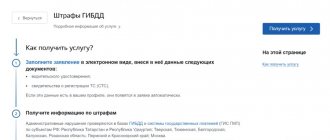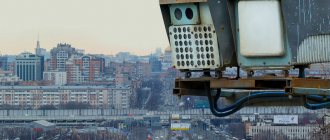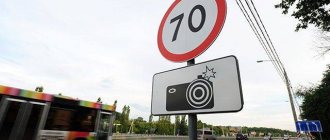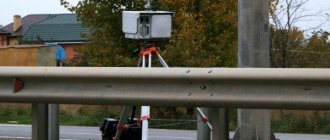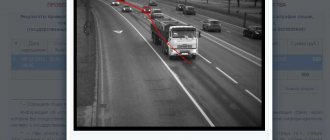Traffic police cameras are designed to reduce accidents on the roads. The first were speed cameras. Improved samples are indexed by navigation programs. Multifunctional devices, or strip cameras, indicate the ability to record multiple violations. A car that has committed a traffic violation and is caught on camera is photographed. The license plate number identifies the owner of the car, to whom a copy of the protocol with the amount of the fine will be sent. In addition, pixel cameras are installed in some traffic lights to record violations.
Penalty for crossing a passing lane when changing lanes
Road markings serve to delimit traffic flows and are used both independently and in conjunction with road signs. The name and graphic display of the types and purposes of markings are prescribed in Appendix 1 to the Russian Traffic Regulations.
Violation of marking requirements is an administrative offense and is punishable in accordance with Art. 12.16 Code of Administrative Offenses of the Russian Federation.
A car driver who changes lanes in the same direction across a solid line, if such a violation is recorded on camera, will receive a penalty of 500 rubles.
A traffic police inspector has the right to issue a fine for crossing a solid line in the same direction. Both options provide preferential payment. In addition, there is a fine for turning across a continuous road.
The role of markup 1.1, where it can be found
Marking 1.1 is a single solid white line and is applied to separate oncoming and passing traffic flows. Markup 1.1 applies:
- to separate oncoming traffic flows;
- marking the boundaries of the strip in places with increased danger;
- marking the border of the roadway with a ban on leaving it;
- division of parking spaces.
Crossing line 1.1 is prohibited from either side. If sign 8.23 or marking 1.24.4 is installed on a road with markings 1.1, this means that this section of the roadway is being viewed by a lane control camera and a violation will be recorded.
Notifying drivers about video recording on the road
8.23
In accordance with the requirements of traffic regulations, the driver must be notified that violations are being recorded on the road section using special devices. For this purpose, sign 8.23 “Photo and video recording” was developed and is being used, or appropriate markings are applied to the road surface. With their help, all road users receive information about possible video recording of violations.
This sign or marking is used on the following sections of the road:
- railway crossings;
- where movement, turns and U-turns are prohibited;
- where overtaking is prohibited or speed limits apply;
- at intersections, pedestrian crossings and in places where stopping or parking is prohibited.
However, drivers should know that the violation was recorded by a special device, but the corresponding sign was missing, this does not exempt him from punishment.
What does the navigator warning about “lane camera” mean?
If the driver did not notice the photo-recording sign, standard car navigators and smartphone applications warn about a control system installed on the road. In addition to notifications about speed cameras, you can hear the phrase in the navigator: “There is a camera ahead of the lane.” This is a warning: the driver must comply with traffic rules not only in terms of speed limits. A modern strip camera is a multifunctional device that can track and take pictures of violations such as:
- exceeding the speed limit established for a given section of the roadway;
- entering the public transport lane;
- crossing a solid marking line in the same direction;
- crossing a solid marking line and entering the oncoming lane;
- roadside travel;
- hitting waffle road markings and creating a traffic jam;
- hitting a stop line;
- driving through a red traffic light;
- hitting a pedestrian crossing marking;
- parking and stopping in a prohibited place.
Constantly improving the functionality of the cameras and updating their software makes it possible to track the use of the phone and neglect of the seat belt. Taking into account the large number of traffic violations being monitored, the navigator notifies that a camera is installed on the lane, warning the driver to comply with traffic rules.
Camera on the strip
Camera on the strip, what does that mean? It turns out that these cameras are different from speed cameras. They are mounted on high masts and cover up to four lanes with their wide-angle lens.
They are equipped with infrared sensors and are able to record traffic flows in all lanes, noting violations in each lane. For example, entering a public transport lane, and as you know it will cost you three thousand rubles.
In addition, such cameras record the trajectory of the vehicle. And if you change lanes aggressively, crossing several lanes at once, you will definitely be caught by this camera.
Also, if, when changing lanes, you cross a solid lane, keep in mind that you will be in the frame of this camera and wait for a letter of happiness. Such violations will cost you 500 rubles.
But the stationary Kordon complex can recognize “roadside traffic,” that is, cars crossing the marking line on the right, which marks the side of the roadway. Cordon also detects traffic in the oncoming lane.
It is against all these violations that Yandex Navigator warns drivers, in a simple expression - Camera on the lane.
Appearance and principle of operation of the strip camera
Based on the principle of operation, there are the following types of special traffic police cameras: laser, radar and video recording. Stationary devices are installed on supports and special structures, while mobile devices can be located in inspectors' cars. To read license plates in conditions of limited visibility, the fixing systems are equipped with infrared spotlights.
The most common devices:
- "Strelka ST" old and new models. They are metal boxes in which an IR illuminator and a Doppler radar are located.
- “Strelka Plus” is a modification of the previous model. It has an oblong body, around which there are IR spotlights. The complex detects lane changes, generating a fine through the server.
- “Auto-hurricane” is installed on each lane. Calculates speed from video recording, not detected by radar detector.
- "Avtodoria" This is a pair complex. Cameras are installed at a distance of 0.5–10 km, record the time of travel under the first and second parts of the complex, after which the average speed is calculated.
Constantly upgrading cameras reduces the percentage of errors, however, if you think that you have been fined illegally, you can file a complaint with the traffic police department or court.
Types of traffic police video cameras
All road video recorders are divided into 2 types:
- Cameras that operate automatically.
- Cameras used by State Traffic Inspectorate employees when imposing fines.
Cameras for automatically recording violations
In theory, such cameras should record all traffic violations, although in practice they record only some of them. By the way, the list of traffic violations that can be recorded by such devices has not yet been legally defined.
Automatic video cameras are:
- portable;
- stationary;
- mobile.
Portable recorders require daily installation and configuration. Practice shows that they are only able to detect that the driver is exceeding the speed limit.
Stationary cameras are very convenient and practical . They are installed in a specific location and configured once. Such systems are capable of filming:
- over speed;
- going to the stop line;
- maneuvering at a prohibitory traffic light;
- leaving a car at an intersection during a traffic jam;
- vehicle entering the oncoming lane;
- entry under a prohibiting sign;
- going to the sidewalk;
- entering the lane designated for route vehicles;
- violation of road markings;
- truck movement beyond the second lane on highways;
- turn from the second row;
- low beam headlights not turned on;
- violation of toll rules for heavy trucks;
- ignoring pedestrians at a zebra crossing.
Attention! The traffic police plans to introduce into the video recording program driving without a compulsory motor liability insurance policy or with a fake policy.
Stationary cameras are capable of monitoring traffic in several lanes at the same time, including oncoming ones.
What types of automatic video recording cameras are there and how do they work?
Several types of such cameras can be installed on the roads of the Russian Federation. Next, let's look at the most common brands:
- The Strelka video device recognizes vehicles that are programmed in its memory. Under ideal conditions, the device sees a target 400-500 meters away, and not just one, but several dozen at once. During this time, the offense is recorded, then the video camera tracks the car. The automation recognizes the number and photographs it 50 m from the system’s location. The radar located inside the device determines the speed, coordinates and license plate number of the vehicle simultaneously.
- The Avtodoriya device calculates the average speed of a car moving at a distance from 100 m to 2-3 kilometers. There is no radar here, there are only cameras that record cars at the beginning and end of the route.
- The stationary complex "AvtoUragan-VSM" is capable of recording 16 types of traffic violations. This device also does not have a radar; it only has a wide-angle video camera, which does not interfere with determining the speed of cars with an error of only 2 km/h. The vehicle's travel time is also recorded.
- The Vocord device also does not use radar. The system measures the average speed only with the lens, taking several frames in a row.
- The Arena camera can be stationary or mobile. Its readable speed range is from 20 to 250 km/h. The camera detects an intruder within a radius of 8 meters. Able to work fully in the dark.
None of the video cameras are free from technical errors. The culprits of errors are usually viruses and computer failure.
Many drivers wonder whether a video camera is capable of recording violators at night.
We answer: modern devices operate in infrared mode, so government signs (even dirty ones) and headlights will be clearly visible on a night image.
Video: How cameras for recording traffic violations work
How do mobile cameras work?
Mobile video cameras are installed in traffic police cars or in public transport.
These devices detect violations in the direction of movement of these vehicles and are able to record:
- over speed;
- violation of parking rules;
- violation of toll rules for heavy goods vehicles.
Cameras operating in conjunction with traffic police officers
Such devices make it possible to confirm the driver’s guilt and impose a fine on him. They record any violation of the rules, but, unlike automatic cameras, they do not send so-called “chain letters.” Traffic police inspectors can only impose a fine manually.
Options for using such cameras:
- The inspector films the traffic violation on camera, then stops the car.
- A traffic police officer records a violation of the rules, then transmits the information to the nearest post, where they stop the driver in order to impose a fine on him.
- The camera is installed in front of the traffic police post. It automatically recognizes license plates of cars passing by, checks them against databases and transmits information to the post. A traffic police officer stops the car and conducts a check.
The main misconceptions of drivers when driving along a passing road
There is a misconception that crossing solid markings is a violation only in the case of driving into oncoming traffic or the side of the road. Drivers mistakenly believe that they can maneuver in lanes in the same direction, despite the 1.1 markings. The traffic rules clearly regulate the prohibition of crossing line 1.1 in any direction, because it is placed before areas with increased danger, such as:
- proximity to the intersection;
- exit to the bridge;
- approaching the tunnel.
Violation of the markings when changing lanes entails a fine of 500 rubles. Also, in order to avoid committing crimes, you need to be well aware of what the intersection monitoring camera records.
Types of video recording cameras
All speed cameras are divided into two main types:
- stationary (installed in a specific location);
- mobile (i.e. mobile).
The latter type also includes radars that are installed on police cars, on tripods (or hand-held), as well as devices for covert surveillance.
The vehicle speed measured by the systems can be average or instantaneous. In the first case, the system is a whole complex of radars that are located on any section of the road.
It must be said that tracking systems are constantly progressing. Now there are cameras that recognize such violations as entering a railway crossing, driving through a red traffic light, crossing road markings, and entering a public transport lane.
Reader Questions
I was returning from the dacha. I didn’t see any camera signs. I almost missed the turn, but noticed it and changed lanes right before the traffic light. A few days later I received a fine for crossing a continuous road. There were no camera signs. Can I challenge the fine?
Answer: A citizen has the right to file a complaint against the actions or inaction of officials. You can challenge this fine. But the presence or absence of a photo recording sign does not negate the very fact of your traffic violation. If the camera is certified, its recording will be considered legal. According to the traffic rules, sign 8.23 is used in conjunction with other road symbols, however, the Rules do not indicate the mandatory installation of sign 8.23.
I took a wrong turn and drove down a one-way road in the other direction. There were no oncoming cars, I quickly turned into the yard, but there was a traffic police camera hanging there. I read in the administrative code that for my violation I could be fined or deprived of my rights.
Answer: According to Part 3 of Art. 12.16 of the Code of Administrative Offenses of the Russian Federation, for a violation you committed, a fine of 5 thousand rubles or deprivation of the right to drive a vehicle is provided for from 4 to 6 months. Considering that your violation could have been recorded on camera, only a fine can be applied to you. Deprivation of a driver's license is provided when a violation is recorded by an inspector.



